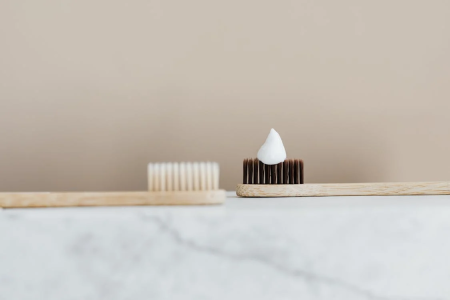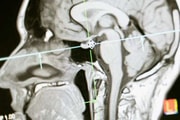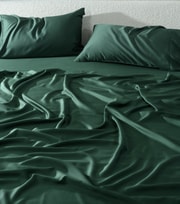The disgusting reason your toothbrush could be covered in faecal particles right now
By
Maan
- Replies 0
Most of us don’t give a second thought to our daily routines, especially when it comes to personal hygiene.a
But what if one simple habit was exposing you to far more bacteria than you ever imagined?
A doctor has shared a startling revelation about a common mistake many people make—one that could be affecting your health without you even realising it.
A toothbrush is something people use at least twice a day, but one expert revealed a common mistake that could make it far less hygienic than expected.
Dr Samuel Choudhury, a doctor based in Singapore, explained that many people stored their toothbrushes too close to the toilet.
This exposed them to bacteria, viruses and even faecal particles.
‘Did you know that flushing the toilet can send bacteria flying up to 6 feet in the air?’ he said.
‘If your toothbrush is chilling next to your toilet, you might be brushing with more than just toothpaste!’
A 2015 study he referenced found that 60 per cent of toothbrushes in a shared dormitory contained traces of faecal matter.
Toothbrush covers, which many assumed would help, actually made the problem worse by creating an environment where bacteria thrived.
‘You may think that this will keep it safe, because it is closed off from aerosolised particles,’ Dr Choudhury said.
‘Think again. Research has shown that keeping a toothbrush in a closed container increases the bacteria load because it gives a very good environment for bacteria to grow.’
He recommended a few simple ways to keep toothbrushes clean, including storing them upright so water could drain properly.
He also advised changing toothbrushes or their heads every three to four months to prevent excessive bacterial buildup.
‘Three, keep the toothbrush away from the toilet bowl, and when flushing, try to keep the toilet lid closed,’ he added.
‘As much as possible, try to keep it away from the toilet and in a well ventilated area so that it dries.’
While UV containers and mouthwash could be used for additional cleaning, he clarified that they were not necessary.
Dr Choudhury’s video gained over 30,000 likes on social media, with many users expressing their shock and disgust.
‘Close the lid when you flush. That’s what it’s there for,’ one person wrote.
Another commented: ‘Great video! Really important info that touches our daily lives and can make a huge difference.’
One user joked: ‘How big do you think our bathrooms are?’
The discussion followed scientific warnings about the dangers of airborne bacteria released during flushing, with experts highlighting risks of exposure to E. coli and Staphylococcus aureus.
Wajid Ali, who led a study from China University of Geosciences, said: ‘Our findings underscore the substantial health risks posed by bioaerosol exposure in public washrooms.’
‘Enhancing ventilation systems by optimising exhaust fan efficiency and air exchange rates can effectively reduce bioaerosol concentrations and exposure risks for the public.’
Watch the full video below.

With so many people unknowingly making this mistake, do you think you’ll be changing where you store your toothbrush? Let us know your thoughts in the comments.
But what if one simple habit was exposing you to far more bacteria than you ever imagined?
A doctor has shared a startling revelation about a common mistake many people make—one that could be affecting your health without you even realising it.
A toothbrush is something people use at least twice a day, but one expert revealed a common mistake that could make it far less hygienic than expected.
Dr Samuel Choudhury, a doctor based in Singapore, explained that many people stored their toothbrushes too close to the toilet.
This exposed them to bacteria, viruses and even faecal particles.
‘Did you know that flushing the toilet can send bacteria flying up to 6 feet in the air?’ he said.
‘If your toothbrush is chilling next to your toilet, you might be brushing with more than just toothpaste!’
A 2015 study he referenced found that 60 per cent of toothbrushes in a shared dormitory contained traces of faecal matter.
Toothbrush covers, which many assumed would help, actually made the problem worse by creating an environment where bacteria thrived.
‘You may think that this will keep it safe, because it is closed off from aerosolised particles,’ Dr Choudhury said.
‘Think again. Research has shown that keeping a toothbrush in a closed container increases the bacteria load because it gives a very good environment for bacteria to grow.’
He recommended a few simple ways to keep toothbrushes clean, including storing them upright so water could drain properly.
He also advised changing toothbrushes or their heads every three to four months to prevent excessive bacterial buildup.
‘Three, keep the toothbrush away from the toilet bowl, and when flushing, try to keep the toilet lid closed,’ he added.
‘As much as possible, try to keep it away from the toilet and in a well ventilated area so that it dries.’
While UV containers and mouthwash could be used for additional cleaning, he clarified that they were not necessary.
Dr Choudhury’s video gained over 30,000 likes on social media, with many users expressing their shock and disgust.
‘Close the lid when you flush. That’s what it’s there for,’ one person wrote.
Another commented: ‘Great video! Really important info that touches our daily lives and can make a huge difference.’
One user joked: ‘How big do you think our bathrooms are?’
The discussion followed scientific warnings about the dangers of airborne bacteria released during flushing, with experts highlighting risks of exposure to E. coli and Staphylococcus aureus.
Wajid Ali, who led a study from China University of Geosciences, said: ‘Our findings underscore the substantial health risks posed by bioaerosol exposure in public washrooms.’
‘Enhancing ventilation systems by optimising exhaust fan efficiency and air exchange rates can effectively reduce bioaerosol concentrations and exposure risks for the public.’
Key Takeaways
- A doctor warned that storing toothbrushes too close to the toilet exposed them to bacteria, viruses and faecal particles due to airborne contamination from flushing.
- A 2015 study found that 60 per cent of toothbrushes in a shared dormitory contained faecal matter, and toothbrush covers worsened bacterial growth instead of preventing it.
- Experts recommended keeping toothbrushes upright, replacing them every three to four months, and storing them in a well-ventilated area away from the toilet.
- Scientists highlighted the risks of airborne bacteria like E. coli and Staphylococcus aureus from flushing, suggesting better ventilation to reduce exposure.
With so many people unknowingly making this mistake, do you think you’ll be changing where you store your toothbrush? Let us know your thoughts in the comments.








